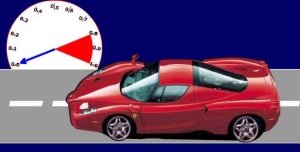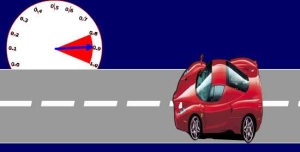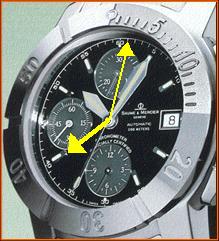Time and distance
Time and distances perception for observers at rest and in motion
- Fantastic! -said Elna, her
imagination now running wild. -
Are there any other interesting curiosities to learn about?
- Well, I think so, - answered Nega looking at her watch, probably to check if she had enough time to start on a new subject before arriving at the Great Party. - You see, we electrons which form this beam are travelling right now at a speed where some important effects begin to be observed.
- Which effects? - exclaimed the two enthusiastic
girl-electrons![]() together.
together.
- Let's explain one step at a time. We said before that Worlds exist, like the Human World, where all bodies travel at low speed. Well, in these Worlds, common experience shows how the observations of a subject at rest and a moving one are different from each other. For example, the trees lining a road seem to be moving towards the driver of a car but appear motionless to the hitch-hiker sitting at the side of the same road. In the same way the dashboard of the car is motionless for the driver (at least we hope so!) but is moving for the hitch-hiker. These properties are so well-known in the Human World that nobody takes it into account. However the differences between the two observers (the driver and the hitch-hiker) are much deeper. Anyway these differences begin to be noticeable only in a World of very high speeds, like the one we are living at this moment.
- Why? -pressed the two girl-electrons.
- Be patient and I'll explain everything. First of all let's see some differences. This is the first: two observers in relative movement have different perceptions of time and of distance. This means that two identical watches, worn by these two observers, don't synchronise, and then don't agree on the time intervals passed between two events. Notice that this isn't due to the accuracy of the two watches, which we suppose are absolutely accurate!
- In the same way, - continued Nega after a pause, - two observers in relative movement, using two identical rules, don't agree on a distance measurement.
- That's impossible, I don't believe you! - exclaimed Elna.
- Try it if you don't believe me, - said Nega laughing. Then, growing more serious: - After all, you are not the only one who doesn't believe it. Many Humans refuse to believe it.
- But why? - asked Elna.
- The reason for their refusal is very simple. These effects depend on the speed of the observers. In cars, in aeroplanes and even on board the Shuttle built by Humans these effects are small. Of course there are differences of perception between a moving and a motionless subject, but they are so small that nobody is able to observe them. Nevertheless, here we are travelling at a speed very close to that of light and, in this case, the effects can be clearly seen.
Time and
distance in the everyday experience
- Can you give us an example of what happens to time
and to the lengths of objects? - exclaimed Elna absolutely
determined to clear up what she had heard.
- Yes, certainly! Imagine that you project yorself into the ordinary Human World. Then imagine driving a very fast car and you decide to measure its speed. To do this, you have obviously to make a time measurement. Your friend Kate is waiting for you at the side of the road with a chronometer identical to yours. Right! If, according to Kate, your car took 30 seconds to cover a certain distance, for you Elna it took only 29.99999999999952 seconds. For sure a normal chronometer won't be able to measure such a small difference. That's why it's not surprising that everyday experience doesn't give any indication of the fact that the time depends on the movement state.
- I see, they are too small differences… - said Kate. - And what about the distances?
- Something similar happens also to distances, - answered Nega quickly. - In the latest example, if Elna (for whom the car is motionless) measures a car length of 4.80 metres, Kate (at the side of the road) notes 4.79999999999958 metres. In this case too, the difference is so small that no measuring instrument could show it.
- As you see from our examples, the differences are microscopic. However they show an irremediable fault in our common conception of time and space, which we think of as immutable and universal. As the relative speed between the two observers increases, the difference becomes more and more visible.
Time
and distances in a World at speeds close to that of light
- Let me explain further, - continued Nega. - If you, Elna,
were travelling in a very fast car at 84 per cent of the light speed and Kate was
motionless at the side of the road, the car length measured by Kate would be
only of 2.3 metres, which is a lot less than the length measured by you, Elna
(and a lot less than the length written on the car documents!).
|
|
|
- So, - said Elna who was paying close attention, - an observer perceives a moving object as much shorter, as if it had shrunk in the direction of movement.
- That's right! - exclaimed Nega clearly pleased.
- Give us another example,- insisted Kate who was still not satisfied.
- Another example? - said Nega thinking. - …Mmm...Yes, there it is! Consider the electrons, like you and me, in this "damned" pipe. At the end of the pipe, if we were to exit travelling at 99.9975 per cent of the speed of light, then every metre of the pipe (moving in relation to us) would appear to us to be 7.1 metres long. That is not a small effect! Don't you agree?
- For sure! - exclaimed Kate.
- Now, please, tell us something about time, - pressed Kate after reflecting a while.
- Right! Let's go back again to the example of the fast car driven by Elna. You, Kate, motionless at the side of the road with your stationary watch, would measure a time almost double that measured by Elna inside the car. It would be as if Elna's watch were slow compared to yours.
- So, if I've got that right, - concluded Kate, - moving clocks tell the time more slowly, that is they move more slowly and then delay. And this delay increases with speed.
- Exactly! - confirmed Nega. - Suppose we bestride a clock moving, for example, at three quarters the speed of light. For a stationary observer our time would fly two thirds more slowly than his. In this case too, the effect is not negligible.
|
|
Unreasonable
things for common sense
The two girl-electrons seemed rather perplexed, so Nega decided to
explain in more detail: - I know that much of what I
have told you today doesn't seem reasonable in the light of everyday
experience. But you have to understand that in the Human World the bases knowledge, which then generate "common sense", are really limited.
Indeed they are restricted to low speeds and, in any case, to speeds
much lower than the speed of light.

(Credit:
Adapted from: Settimana
Enigmistica)


